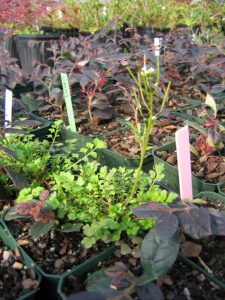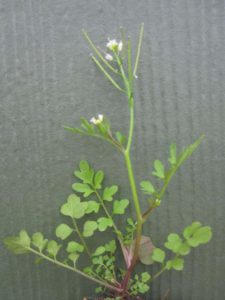Last Updated on September 16, 2020 by Yuvraj
Welcome to Weed Science Wednesday, a weekly series aimed at helping homeowners and horticulture professionals better identify and manage common landscape weeds in Florida.
The weed of the week is Hairy bittercress (Cardamine hirsuta). Hairy bittercress is native to Europe and Western Asia and has been introduced and naturalized in the United States. It is a winter annual but in Florida, it can persist year-round in moist and shaded areas. It is a common weed in greenhouses, container pads, growing media, and nursery pots. It is often found in irrigated or shaded areas but can also grow in full sun.

Bittercress with clumping growth habit in container
Hairy bittercress has an upright growth habit or forms a dense basal rosette. The stems are often reddish to purple in color towards the base of the plant. It usually grows 3 to 8 inches long. The leaves are compound, alternately arranged on the stem, and often club-shaped. The flowers are white with four petals and found at the top of the stem in clusters. One bittercress plant can produce about five thousand seeds that have no dormancy requirement and can germinate quickly.

Mature bittercress. Note the purplish color and leaves forming a basal rosette at the bottom of the stem
For more information on Hairy bittercress, including specific recommendations for chemical, physical and cultural weed controls, please consult Biology and Management of Hairy Bittercress (Cardamine hirsuta) in Ornamental Crop Production
 0
0
